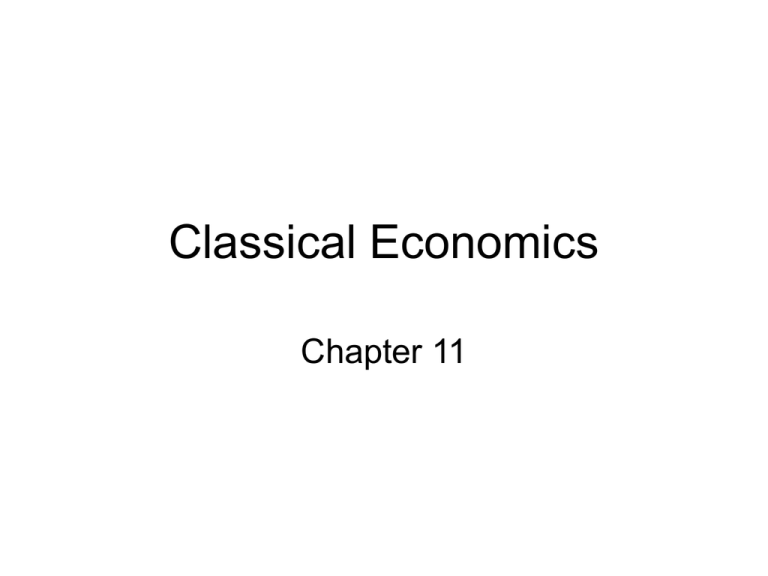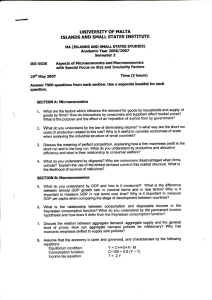
Classical Economics
Chapter 11
Part I: The Classical
Economic System
• The centerpiece of classical economics
is Say’s law
– Say’s law states, “Supply creates its own
demand”
– This means that somehow, what we
produce – supply – all gets sold
Copyright 2002 by The McGraw-Hill Companies, Inc. All rights reserved.
11-4
Why Does Anybody Work?
• People work because they want money to
buy things
– People who produce things are paid. They
spend this money on what other people
produce
– As long as everyone spends everything that he
or she earns, the economy is OK
• But, the economy begins to have problems when
people save part of their incomes
– People do save, and saving is crucial to
economic growth
• Without saving, we could not have investment – the
production of plant, equipment, and inventory
Copyright 2002 by The McGraw-Hill Companies, Inc. All rights reserved.
11-5
Consumer Goods and Investment Goods
• Think of production as consisting of
two products: consumer goods and
invest-ment goods (for now, we’re
ignoring government goods)
• The money spent on consumer goods
is designated by the letter C
• The money spent on investment goods
is designated by the letter I
Copyright 2002 by The McGraw-Hill Companies, Inc. All rights reserved.
11-6
Consumer Goods and
Investment Goods
If we think of GDP as total spending, then
GDP would be C + I
If we think of GDP as income received, then
GDP would be C + S
Copyright 2002 by The McGraw-Hill Companies, Inc. All rights reserved.
11-7
Consumer Goods and
Investment Goods
If we think of GDP as total spending, then
GDP would be C + I
If we think of GDP as income received, then
GDP would be C + S
GDP = C + I
GDP = C + S
Copyright 2002 by The McGraw-Hill Companies, Inc. All rights reserved.
11-8
Consumer Goods and
Investment Goods
GDP = C + I
GDP = C + S
And since things equal to the same thing are equal to
each other, we have
C+I=C+S
Copyright 2002 by The McGraw-Hill Companies, Inc. All rights reserved.
11-9
Consumer Goods and
Investment Goods
GDP = C + I
GDP = C + S
Things equal to the same thing are equal to each other
C+I=C+S
Next, we can subtract the same thing from both sides
of the equation. In this case we subtract C
I=S
Copyright 2002 by The McGraw-Hill Companies, Inc. All rights reserved.
11-10
Say’s Law Revisited
Households
Households
The economy produces a supply of
consumer goods and investment
goods (Aggregate Supply = AS)
7.0 AS
Firms
Copyright 2002 by The McGraw-Hill Companies, Inc. All rights reserved.
11-11
Say’s Law Revisited
S=0.5 They save the rest
Households
Households
AS=7.0
The people who produce
these goods (Households)
spend part of their incomes
on consumer goods
C=6.5
Firms
I=0.5
Their savings are
borrowed by investors
who spend this money on
investment goods
11-12
Copyright 2002 by The McGraw-Hill Companies, Inc. All rights reserved.
Say’s Law Revisited
S=0.5
Households
Households
AS=7.0
GDP = C + I
GDP = 6.5 + 0.5
GDP = 7.0
C=6.5
I=S
Firms
I=0.5
GDP = 7.0 = Aggregate Demand (AD)
We can see that Say’s law holds up, at least in accordance with classical analysis.
Supply does create its own demand. Everything produced is sold. (AS = GDP=AD)
Copyright 2002 by The McGraw-Hill Companies, Inc. All rights reserved.
11-13
Supply and Demand
Revisited
The curves cross at a
price of $7.30 and a
quantity of 6
10
S
9
8
7
D
6
2
4
Copyright 2002 by The McGraw-Hill Companies, Inc. All rights reserved.
6
8
Quantity
10
12
14
11-14
Supply and Demand Revisited
The Loanable Funds Market
The demand and
supply curves cross at
an interest rate of 15
percent
Supply of
savings
20
15
10
5
Demand f or
investment
f unds
0
Quantity of loanable f unds
Copyright 2002 by The McGraw-Hill Companies, Inc. All rights reserved.
11-15
Supply and Demand
Revisited
If the quantity supplied is
greater than the quantity
demanded at a certain price
(in this case $8), the price
will fall to the equilibrium
level ($6), at which quantity
demanded is equal to
quantity supplied.
Market for Hypothetical Product
14
S
12
10
8
6
4
2
D
0
Quantity
Copyright 2002 by The McGraw-Hill Companies, Inc. All rights reserved.
11-16
Supply and Demand Revisited
Hypothetical Labor Market
If the wage rate is set too high
($9 an hour),the quantity of
labor supplied exceeds the
quantity of labor demanded.
The wage rate falls to the
equilibrium level of $7; at
that wage rate, the quantity of
labor demanded equals the
quantity supplied
20
Supply of
labor
18
16
14
12
10
8
6
4
2
Demand
f or labor
0
Quantity of labor
Copyright 2002 by The McGraw-Hill Companies, Inc. All rights reserved.
11-17
The Classical Equilibrium: Aggregate
Demand Equals Aggregate Supply
• On the micro level, when quantity demanded
equals quantity supplied, we’re at equilibrium
• On the macro level, when aggregate demand
equals aggregate supply, we’re at equilibrium
• The classical economist believed our
economy was either at, or tending toward , full
employment
• So at classical equilibrium – the GDP at which
aggregate demand was equal to aggregate
supply – we were at full employment
Copyright 2002 by The McGraw-Hill Companies, Inc. All rights reserved.
11-18





